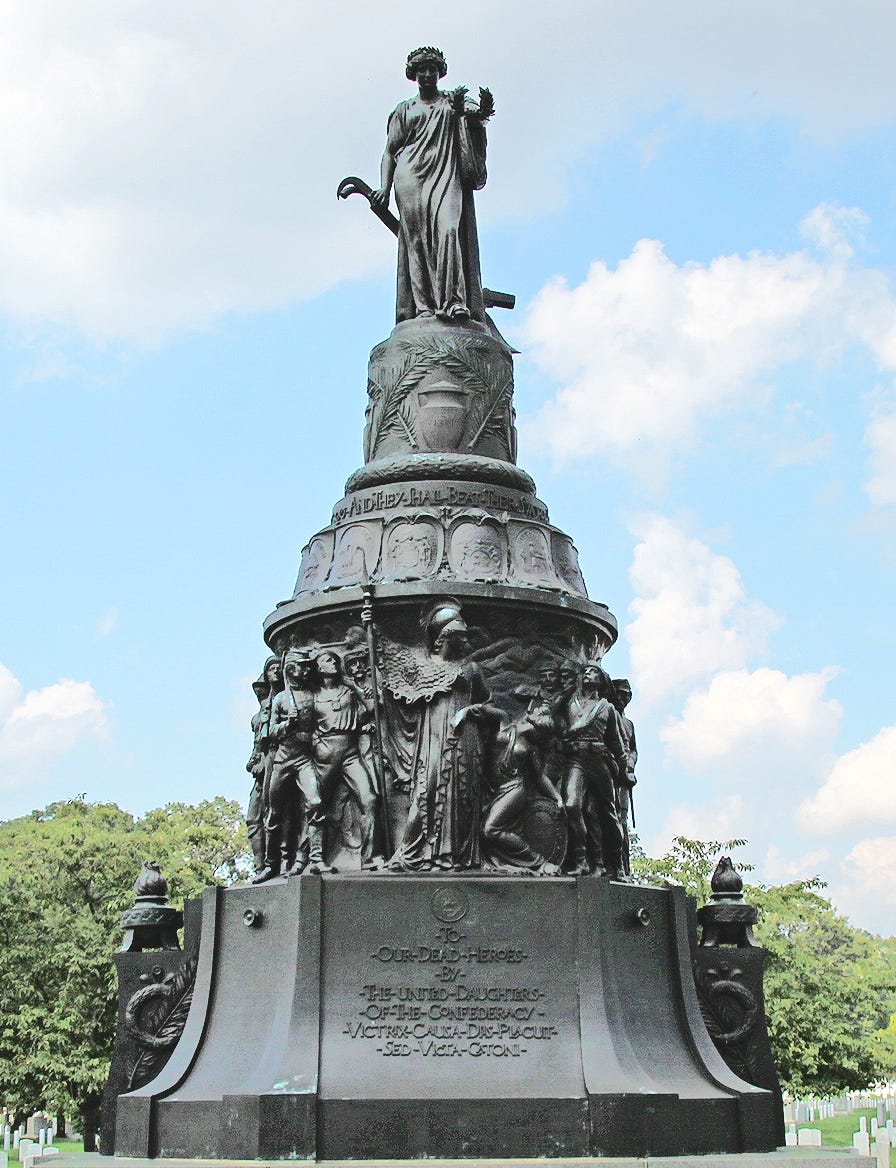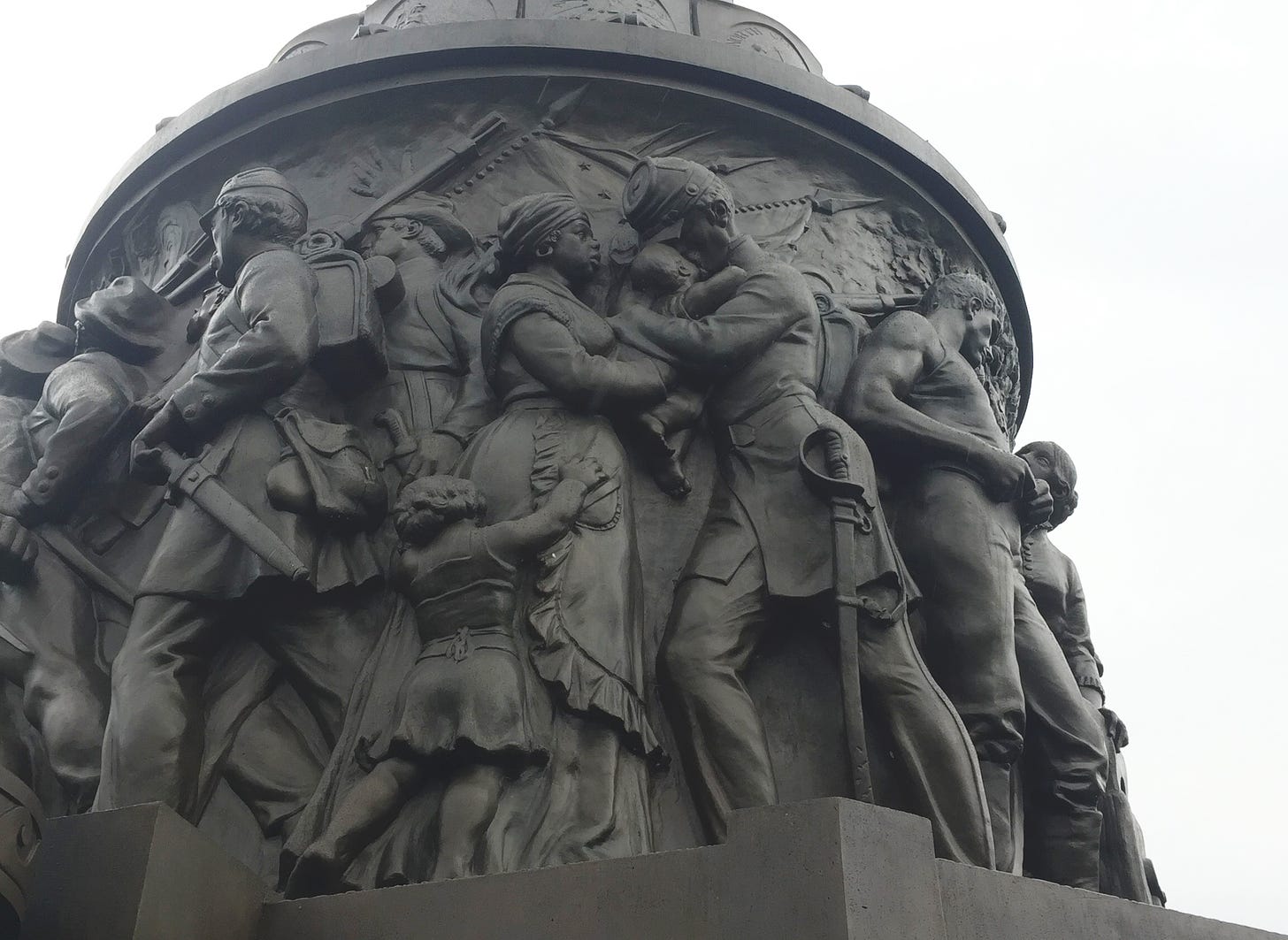Today I had the opportunity to help out with a tour of Arlington National Cemetery organized by Fords Theatre for history teachers. Arlington is one of my favorite places to bring teachers in the D.C. area. There is so much history to interpret. Today we stopped at Arlington House to see and discuss their new exhibits on the enslaved, Section 27, the oldest section of the cemetery, where you will find United States Colored Troops as well as Black “citizens” and “civilians.”
But as you might imagine my favorite spot is the Confederate memorial, which was dedicated in 1914. It’s an incredibly challenging site to interpret. Many of the teachers are confused by its presence, but it’s my job to help them put it into context and fit it into our broader discussion of Civil War memory.
One of the challenges of interpreting the Confederate monument and monuments generally is in reminding people that they did not exist in a vacuum. These monuments must be understood as reflections of the social and political landscape.
For this memorial it is important to connect it to the changing racial landscape of D.C. once Woodrow Wilson became president in 1913. He was the first southern Democrat elected since before the Civil War. His arrival signaled a dramatic shift in the segregation policies in federal office buildings in D.C. Wilson also spoke at the dedication of the Confederate memorial in Arlington.
The federal government employed thousands of Black Washingtonians. Many were low paid laborers, but some were promoted to positions of responsibility and authority once the civil service exam was instituted. Promotions were supposed to be based on merit rather than nepotism, bribery, etc.
Today I began my interpretation of the memorial by introducing the group to Rosebud Murraye and John Abraham Davis.
Murraye was born in 1885 in North Carolina and graduated from the Scotia Seminary at the age of nineteen. She worked in the Bureau of Engraving & Printing Office in D.C. for nine years before Wilson’s election. The records suggest that she was an exemplary employee, who was promoted numerous times. Once Wilson was elected, however, her workplace began the process of segregating employees, including in the cafeteria. On one occasion Murraye refused to leave her seat after being told to move to the Black section. She was eventually fired for insubordination.
Davis was a native Washingtonian, who had worked for the Government Printing Office for thirty years leading up to Wilson’s inauguration. He started out at 25 cents per day, but eventually supervised fourteen people, including white employees. His salary topped out at $1400. Within months of Wilson taking office Davis had been demoted back to a laborer and the same salary he earned in his first year of employment. Davis and his family went from middle class to living in poverty.
So, what’s the connection to the Confederate memorial in Arlington?
These stories are a reminder that how how we remember the past has everything to do with the present. This is something that Frederick Douglass understood all too well throughout the postwar years. He understood that keeping the emancipationist memory of the war alive was integral to the cause of Black civil rights and equality in the workplace. He lived long enough to see the beginning of the flurry of Confederate monument dedications that would take place roughly between 1890 and 1930.
Let’s be clear, Arlington’s Confederate memorial didn’t cause Murraye and Davis to lose their livelihoods, but this monument did reinforce a deeply racist belief that African Americans have always acquiesced to a subservient position to white Americans. That is exactly what the uniformed Black body servant and “mammy” figures symbolize on the memorial. The message is clear: African Americans were content with slavery and in freedom must accept second class status.
It’s no accident that Murraye lost her job, that Davis was demoted, and that federal office buildings were increasingly being segregated in 1914—the very same year that Wilson helped to dedicate the Confederate memorial in Arlington.






My wife and I were there last year and I was struck by the "record scratch" of a Confederate monument at Arlington. It is so out of place there. No other groups that fought against the US have such representation at Arlington. Thanks for highlighting it.
As a young Marine stationed at Quantico, I visited Arlington many times. I did not know the history or actual context of the creation of this section and the raising of this monument. Your post today prompted me to do some reading about it. Your writings in this forum give a bit of context to the following quotes, but I'm looking forward to your book for a fuller picture.
"A uniformed black slave, following his master to war, is depicted among the six figures on the southeast. The slave is not a soldier, although the image is often referred to as a "black soldier". It is, as the UDC pointed out in 1914, "a faithful Negro body-servant following his young master". This particular image was inspired by Thomas Nelson Page's 1887 Lost Cause story, Marse Chan: A Tale of Old Virginia."
"The inclusion of the "faithful black servants" was purposeful. Sculptor Moses Ezekiel included them because he wanted to undermine what he called the "lies" told about the South and slavery in Harriet Beecher Stowe's 1852 novel Uncle Tom's Cabin and wished to rewrite history "correctly" (his word) to depict black slaves' support for the Confederate cause."